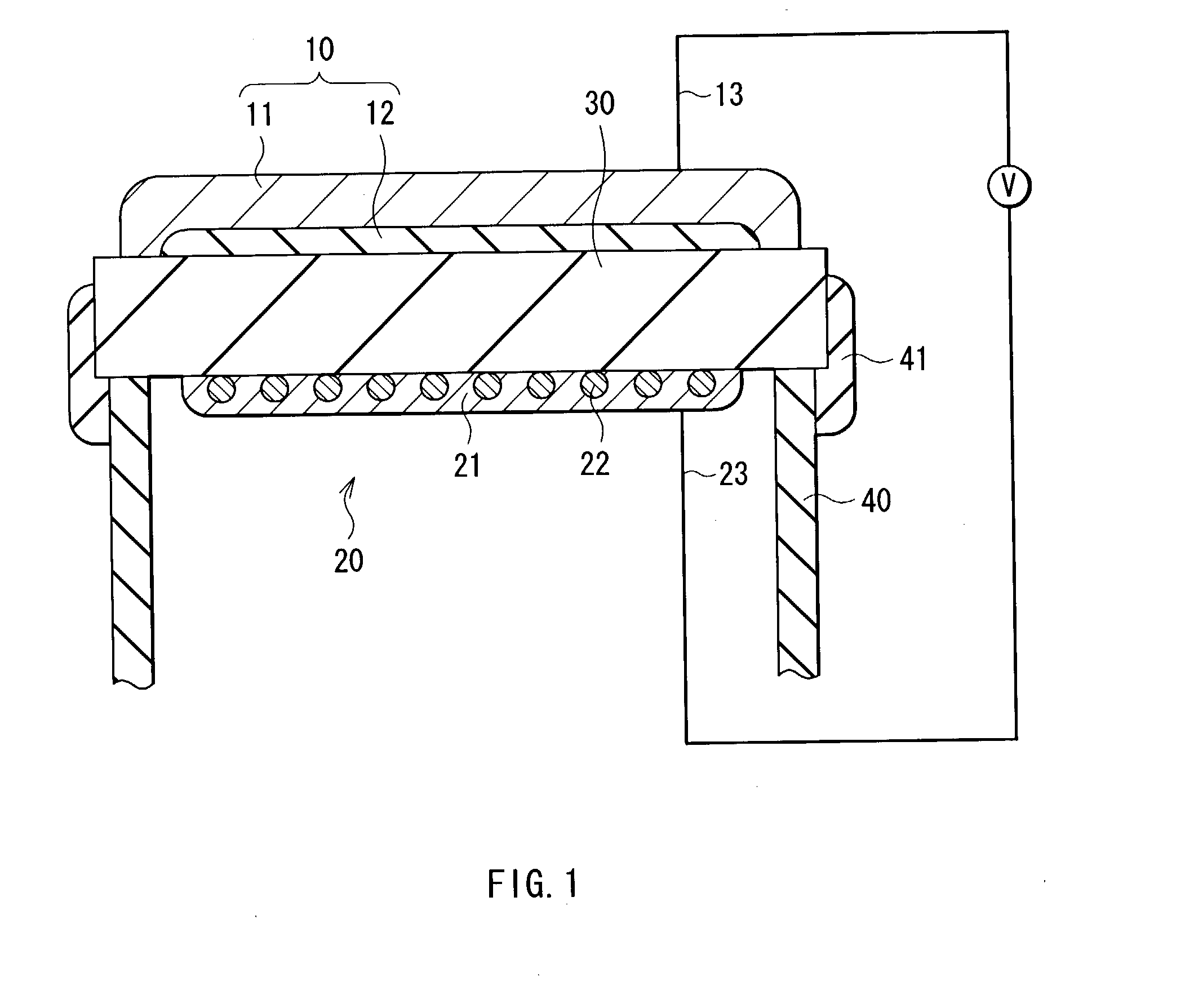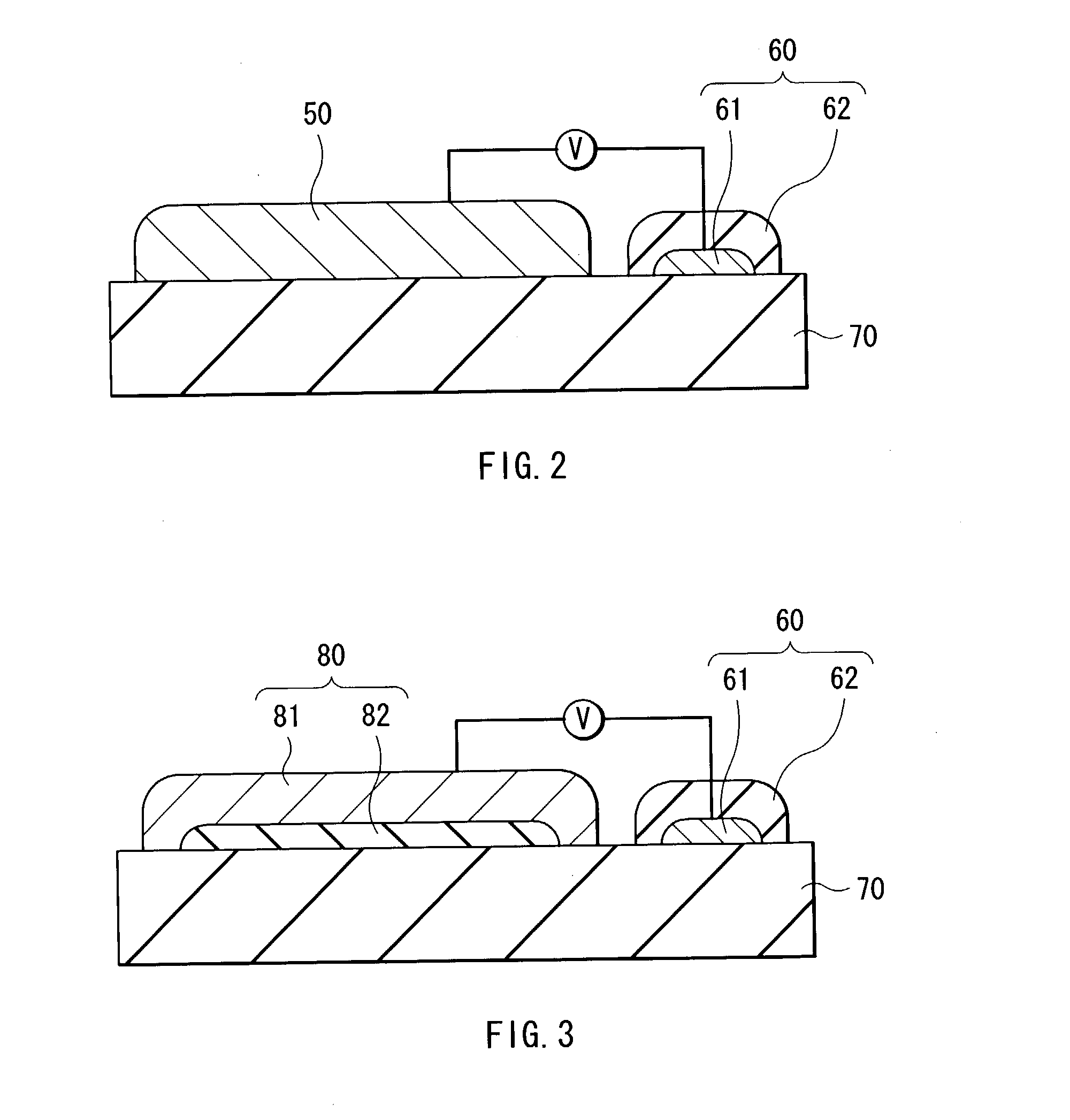Carbon dioxide sensor
a carbon dioxide and sensor technology, applied in the field of carbon dioxide sensors, can solve the problems of difficult to monitor only the concentration of carbon dioxide, the carbon dioxide sensor is not widely used, and the humidity of the sensor is susceptible to humidity
- Summary
- Abstract
- Description
- Claims
- Application Information
AI Technical Summary
Problems solved by technology
Method used
Image
Examples
example 1
[0083] A carbon dioxide sensor as shown in FIG. 1 was formed. First, NASICON powder was prepared by sol-gel method and a discoid electrolyte 30 having a diameter of 9 mm and a thickness of 1.2 mm was formed by using the NASICON powder. Next, a gold paste was applied to the entire surface of the electrolyte 30 together with a gold mesh 22 and a gold wire to be a lead 23, and a powder electrode 21 was formed by heat treatment at 800.degree. C. for two hours in the atmosphere to form a counter electrode 20. Subsequently, a quartz glass tube 40 of 9 mm in diameter was attached to the electrolyte 30 on the side where the counter electrode 20 was provided with an adhesive layer 41 using an inorganic adhesive.
[0084] After that, lithium carbonate powder and an organic solvent containing 5% by mass of ethyl cellulose and 95% by mass of .alpha.-terpineol were mixed with substantially equal weight each to form the paste, and the paste was applied to the surface of the electrolyte 30.
[0085] Ind...
example 2
[0090] A carbon dioxide sensor was formed like Example 1 except that lithium carbonate paste was applied to the electrolyte 30, heated at 750.degree. C., which was higher than the melting point of lithium carbonate, in the atmosphere, extracted at the time of melting and fusion bonding the metal carbonate layer 12, and after that the composite oxide paste of indium and tin was applied thereon and heated at 500.degree. C. for 30 minutes in the atmosphere to form the metal oxide layer 11.
[0091] The relation of electromotive force and carbon dioxide concentration at room temperature at 30%, 50% and 70% humidity for the obtained carbon dioxide sensor of Example 2 were examined like the first embodiment. The results of Example 2 are shown in FIG. 7. As seen in the comparison of FIGS. 5 and 7, the difference of the absolute value of electromotive force to the carbon dioxide concentration by humidity of Example 1 was smaller than that of Example 2. That is, when the metal carbonate layer 1...
examples 3-1 to 3-4
[0093] The carbon dioxide sensors shown in FIG. 1 were formed like Example 1 except for the change of the configuration of the detection electrode 10. Specifically, the complex carbonate paste of alkali metal carbonate of a first component and barium carbonate of a second component or alkali metal carbonate paste was applied to the electrolyte 30 and then dissolved at a temperature higher than the melting point of alkali metal carbonate in the atmosphere to fusion bond the metal carbonate layer 12, and the composite oxide paste of indium and tin was applied thereon and heated at 500.degree. C., which is lower than the melting point of alkali metal carbonate in the atmosphere for 30 minutes to form the metal oxide layer 11.
[0094] At this time, the complex carbonate of potassium carbonate and barium carbonate was used in Example 3-1, potassium carbonate was used in Example 3-2, the complex carbonate of lithium carbonate and barium carbonate was used in Example 3-3, and lithium carbona...
PUM
 Login to View More
Login to View More Abstract
Description
Claims
Application Information
 Login to View More
Login to View More - R&D
- Intellectual Property
- Life Sciences
- Materials
- Tech Scout
- Unparalleled Data Quality
- Higher Quality Content
- 60% Fewer Hallucinations
Browse by: Latest US Patents, China's latest patents, Technical Efficacy Thesaurus, Application Domain, Technology Topic, Popular Technical Reports.
© 2025 PatSnap. All rights reserved.Legal|Privacy policy|Modern Slavery Act Transparency Statement|Sitemap|About US| Contact US: help@patsnap.com



